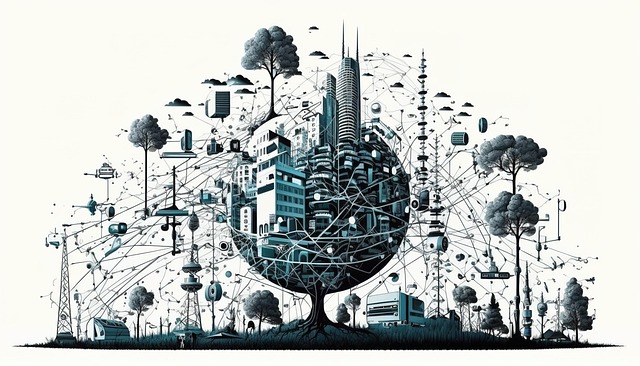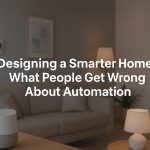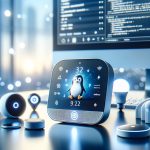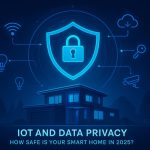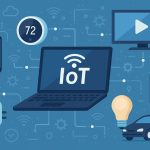The Internet of Everything (IoE) is more than just a tech buzzword—it’s a sweeping transformation of how people, processes, data, and things connect to bring greater value to our lives and industries. While IoT (Internet of Things) refers specifically to interconnected devices, IoE expands this concept to include the human and business aspects that drive meaningful outcomes.
What is the Internet of Everything?
At its core, the Internet of Everything is the intelligent connection of people, processes, data, and things. It’s about creating enhanced experiences, improved efficiency, and more informed decisions by integrating the digital and physical worlds.
In short, IoE = People + Process + Data + Things.
This broader vision builds upon IoT by incorporating a human-centric layer that gives the technology context and purpose. The devices are not just connected—they are part of a larger system that uses analytics, automation, and AI to deliver value.
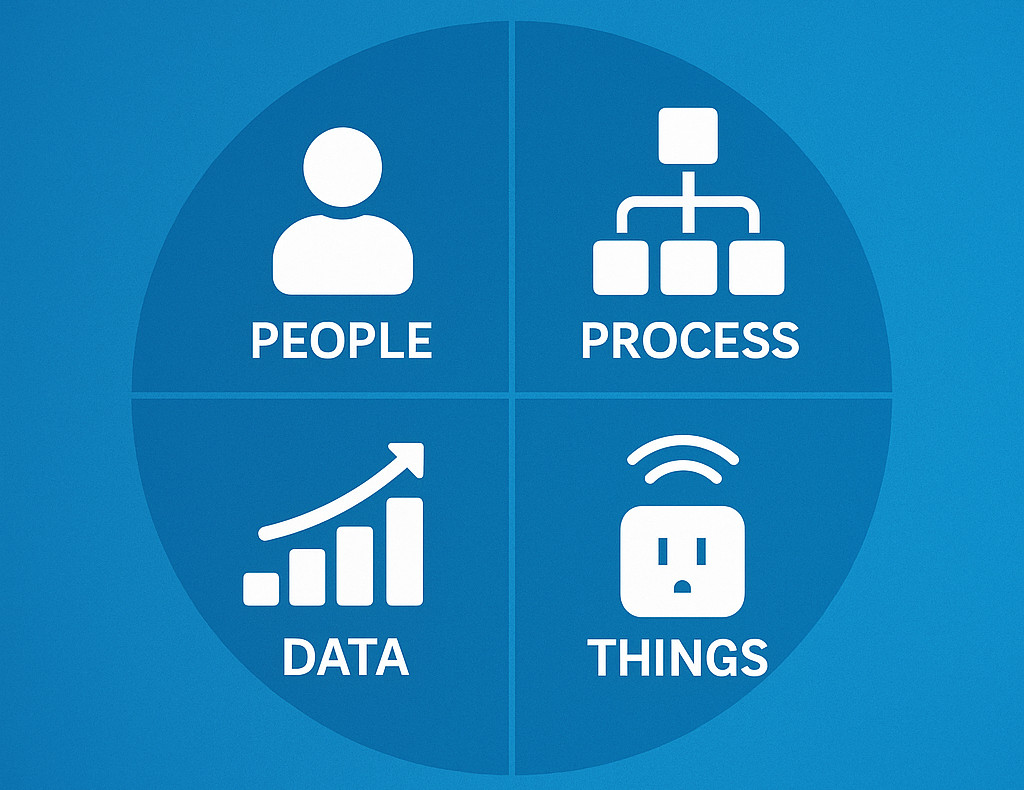
The Four Pillars of IoE
- People
Humans using connected devices—whether smartphones, wearables, or voice assistants—generate data and interact with systems that respond in real time. - Process
Refers to workflows and automation that ensure the right information is delivered to the right person or device at the right time. - Data
Massive amounts of data are generated by connected devices. IoE emphasizes analyzing this data to extract actionable insights. - Things
These are the physical devices—sensors, actuators, appliances, vehicles—that are embedded with connectivity and intelligence.
Examples of the Internet of Everything in Action
1. Smart Cities
Traffic lights adjusting in real-time based on congestion levels, public transport updates sent directly to citizens’ phones, and waste bins that notify sanitation departments when full.
2. Healthcare Systems
Remote patient monitoring, AI-powered diagnostics, and wearable devices that feed real-time data into hospital dashboards—reducing emergency visits and improving outcomes.
3. Retail Environments
Smart shelves that update inventory, in-store analytics that track customer behavior, and personalized offers sent as customers walk by.
4. Education
Smart classrooms with AI tutors, automated grading systems, and virtual reality labs that make science experiments accessible remotely.
5. Manufacturing
Predictive maintenance using real-time machine data, AI-driven supply chain management, and robotic systems that adjust processes dynamically.
IoE vs. IoT: What’s the Difference?
While often used interchangeably, IoE is broader than IoT:
| Feature | Internet of Things (IoT) | Internet of Everything (IoE) |
|---|---|---|
| Focus | Devices & sensors | People, Process, Data & Things |
| Scope | Narrower | Broader and more integrated |
| Use of Data | Mainly device-generated | Includes human and system insights |
| Intelligence Layer | Basic connectivity | Smart insights, automation |
Benefits of the Internet of Everything
- Efficiency: Streamlined processes and reduced human error
- Productivity: Faster and more accurate decision-making
- Personalization: Tailored experiences for users and customers
- Cost Savings: Reduced downtime, better resource allocation
- Sustainability: Optimized energy use and waste management
Challenges Ahead
Despite its promise, IoE still faces obstacles:
- Privacy & Security Risks
- Data Overload
- Infrastructure Costs
- Standardization Issues
However, ongoing advancements in cybersecurity, 5G, and AI are helping mitigate many of these concerns.
Where Is IoE Headed?
In the future, IoE will power autonomous cities, hyper-personalized services, and next-level automation in every field—from agriculture to aerospace. As AI continues to evolve, the synergy between people, data, and connected systems will define how we work, live, and interact.
IoE In a nutshell
The Internet of Everything is more than a network—it’s a new way of thinking. As the lines between the digital and physical continue to blur, IoE offers a powerful framework for building smarter, more connected societies.
The Smart Home Setup Starter Guide for Beginners
- Designing a Smarter Home in 2026: What People Get Wrong About Automation
 Smart homes were once science fiction, but today they’re a reality in millions of households. With voice assistants, smart plugs, and automated lighting systems, it’s easy to assume home automation is simply a matter of plugging in a few devices. Yet, many homeowners quickly discover that “smart” doesn’t always mean simple. In this article, we’ll…
Smart homes were once science fiction, but today they’re a reality in millions of households. With voice assistants, smart plugs, and automated lighting systems, it’s easy to assume home automation is simply a matter of plugging in a few devices. Yet, many homeowners quickly discover that “smart” doesn’t always mean simple. In this article, we’ll… - Automated Online Trading: How IoT is Redefining Financial Markets
 Introduction automated online trading In a world where milliseconds can decide millions, the fusion of Internet of Things (IoT) technology and automated online trading is reshaping global finance. What once relied solely on human judgment now increasingly depends on connected machines, real-time data, and predictive algorithms. From weather sensors influencing agricultural trades to smart logistics…
Introduction automated online trading In a world where milliseconds can decide millions, the fusion of Internet of Things (IoT) technology and automated online trading is reshaping global finance. What once relied solely on human judgment now increasingly depends on connected machines, real-time data, and predictive algorithms. From weather sensors influencing agricultural trades to smart logistics… - The Role of Linux in IoT: Powering the Connected World
 The Internet of Things (IoT) is everywhere—from smart homes and wearable devices to industrial automation and self-driving cars. Behind the scenes, one operating system plays a surprisingly dominant role: Linux. Known for its stability, flexibility, and open-source nature, Linux has become the backbone of countless IoT devices and platforms. But what makes Linux so well-suited…
The Internet of Things (IoT) is everywhere—from smart homes and wearable devices to industrial automation and self-driving cars. Behind the scenes, one operating system plays a surprisingly dominant role: Linux. Known for its stability, flexibility, and open-source nature, Linux has become the backbone of countless IoT devices and platforms. But what makes Linux so well-suited… - The Smart Home Revolution in 2025: How IoT is Transforming Everyday Living
 In the past decade, the vision of a truly smart home has moved from futuristic fantasy to everyday reality. As we step into 2025, the Internet of Things (IoT) has matured into a robust ecosystem, connecting appliances, security systems, lighting, and even entertainment devices under one seamless digital roof. The result? Homes that are safer,…
In the past decade, the vision of a truly smart home has moved from futuristic fantasy to everyday reality. As we step into 2025, the Internet of Things (IoT) has matured into a robust ecosystem, connecting appliances, security systems, lighting, and even entertainment devices under one seamless digital roof. The result? Homes that are safer,… - IoT and Data Privacy: How Safe Is Your Smart Home in 2025? – IoT Security
 The smart home revolution has made everyday life more convenient than ever. From voice assistants that control the lights to security cameras that send alerts directly to your phone, connected devices have become part of our daily routines. But with this convenience comes an important question: how safe is your personal data in a world…
The smart home revolution has made everyday life more convenient than ever. From voice assistants that control the lights to security cameras that send alerts directly to your phone, connected devices have become part of our daily routines. But with this convenience comes an important question: how safe is your personal data in a world…
